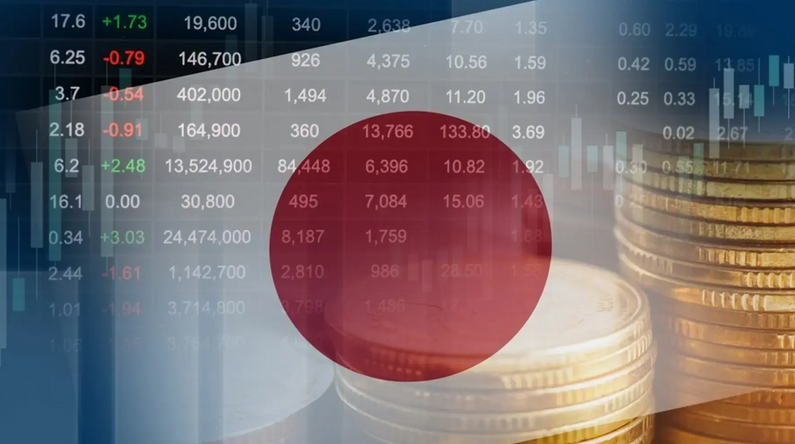Japan: Bonding to a Past or its Future?
Japan’s government bond (JGB) market—once the epitome of stability—is now flashing warning signs. Yields on long-term bonds are rising, demand from institutional buyers is waning, and the Bank of Japan (BoJ) is quietly wrestling with the limits of its monetary strategy.

Japan’s government bond (JGB) market—once the epitome of stability—is now flashing warning signs. Yields on long-term bonds are rising, demand from institutional buyers is waning, and the Bank of Japan (BoJ) is quietly wrestling with the limits of its monetary strategy. But these symptoms are only the latest in a 50-year saga of hypergrowth, crisis, and stagnation. This current crisis represents the culmination of five decades of extraordinary economic transformation, from the meteoric rise and catastrophic collapse of the asset price bubble in the late 1980s to the prolonged period of deflation and stagnation known as the Lost Decade, followed by unprecedented monetary policy experiments that are now being unwound.
For years, decades even, Japan’s interest rates have been at rock bottom lows. So it’s a big deal that 30-year Japanese bond yields poked above 3% and hit their highest since the early 2000s.
There’s a confluence of factors which are driving the yield increase:
- The Bank of Japan (BOJ) has been reducing their bond purchases in a lengthy process of normalising monetary policy. This process began with dropping yield curve control (YCC), where the BOJ targeted yields on 10-year JGBs. On top of tapering, the BOJ has gradually lifted short-term policy interest rates since early last year, although they remain low compared to other advanced economies at 0.50%.
- Inflation has consistently held above its 2% target for three years, and both headline and core inflation are closer to 3% rather than 2%.
- The rise in US bond yields has translated to higher yields elsewhere in the world.

There’s a clear reason based on inflation and BOJ policy to justify the lift in yields. And let’s face it – yields at just above 3% are not high when compared to the days before yield curve control or compared with countries where central banks have not conducted large scale bond purchases. In fact, with inflation being persistently above 3% over the past few years, a 30-year yield near 3%, or even above would make sense.

But the rise in Japanese longer-dated yields are also occurring with a backdrop where longer-dated US yields have also lifted. There are questions arising about the attractiveness of US government debt, namely whether US bonds are still considered the same safe haven as it once was.
Japan’s net government debt is undoubtedly high, at a lofty 134% of GDP. It’s higher than the current net debt as a percentage of GDP in the US at just under 100%. Indeed, Japan’s prime minister, Shigeru Ishiba, recently compared Japan’s fiscal position to Greece.
But while debt as a percentage of GDP is somewhat comparable to Greece when it defaulted, there are a few important differences between the two countries.
Firstly, Japan has a current account surplus – meaning that it’s a creditor to the rest of the world. It means that government borrowings are in a way offset by savings from the rest of Japan. Greece had a large current account deficit when it defaulted, and it still does. That means Greece’s government had to rely on offshore creditors to purchase its debt.
Secondly, Greece was tied to the euro, so Greece didn’t have its own currency to devalue, nor could its central bank be a lender of last resort.
This last point is important, because the Bank of Japan (BOJ) currently owns around half of all Japanese government bonds (JGBs). During yield curve control, the BOJ held almost the whole JGB market. The BOJ has the ability to simply adjust their purchases of bonds, if the JGB market becomes disrupted.
That ability does however, depend on inflation.
Most measures of core inflation have been rising of late. The so-called core-core measure (which excludes fresh food and energy) sits at 3%, and its highest in a year as of April.
However, there’s good reason to think that inflation won’t push higher from here, and odds are that it will ease.
Firstly, demand in Japan economy is weakening, thanks to Trump’s trade uncertainty. Its economy contracted 0.2% in the first quarter of 2025. Trade played a big role in the contraction, but weakness in domestic demand, specifically in consumer spending point to prices pressures fading.

Secondly, the stronger yen, not only exacerbates export weakness further, it brings down import prices. The yen has been volatile over the past year or so. But given the yen has held below 150 over the past couple of months, it further suggests that inflation will eventually come down and could come down significantly if yen strength persists.

Of course, there are dynamics occurring in the bond market right now that no one can realistically know how it will play out. This is especially the case if we see growing concerns about the US fiscal situation, and bigger questions over the role of US treasuries as a safe haven. What could a structural shift in role of US treasuries mean? Would other bonds, government or corporate, end up decoupling to some extent from US treasuries? And if not, would a longer-running sell-off in US treasuries extend to all government bonds?
This transformation reflects deeper structural challenges rooted in decades of economic policy decisions, demographic changes, and the long-term consequences of Japan's unique approach to managing economic crises through unconventional monetary policy tools.
Current Bond Market Volatility and Policy Unwinding
Japan's bond market is experiencing unprecedented stress as the government prepares to auction ¥500 billion worth of 40-year bonds amid rising yield volatility that is reverberating through global debt markets
The 40-year bond yield has climbed eight basis points to 3.365% as of Wednesday morning in Tokyo, reflecting growing investor concerns about the sustainability of Japan's fiscal position. This volatility represents a critical test for longer-maturity bonds as markets grapple with rising government spending and expanding budget deficits that threaten to push Japan's fiscal situation into dangerous territory
The current crisis is fundamentally rooted in the Bank of Japan's decision to abandon its yield curve control policy, which had artificially suppressed long-term interest rates since 2016
The central bank's withdrawal from massive government bond purchases has created a significant gap in demand that institutional investors have been reluctant to fill, amplifying the challenges facing Japan's bond market. The 10-year government bond yield, which serves as a crucial benchmark for the entire yield curve, has experienced remarkable volatility, rising from 1.02% in May 2024 to 1.52% by May 2025. This represents not only a 49.80% increase year-over-year but also signals the end of an era of artificially suppressed borrowing costs that had become a cornerstone of Japan's economic policy framework
The implications of this yield surge extend far beyond the bond market itself, as higher borrowing costs threaten to undermine the government's ability to service its massive debt burden while simultaneously calling into question the sustainability of Japan's fiscal trajectory. The current situation represents a fundamental inflection point where decades of unconventional monetary policy are being tested against market forces, with potentially far-reaching consequences for both domestic economic stability and global financial markets.
Economic Foundations and Growth Period (1970s-1980s)
Japan's economic trajectory over the past five decades began with a period of remarkable growth and industrialization that set the stage for both unprecedented prosperity and eventual crisis. During the 1970s and early 1980s, Japan emerged as a global economic powerhouse, building upon the rapid industrialization that had characterized the post-war recovery period. The country's manufacturing sector became increasingly sophisticated, with Japanese companies gaining worldwide recognition for their innovation in electronics, automobiles, and precision machinery. This period of sustained growth was supported by a unique economic model that emphasized close cooperation between government, banks, and corporations, creating an environment conducive to long-term investment and technological advancement.
The foundation for Japan's economic success during this period was built upon several key structural elements that would later contribute to its vulnerability during the bubble years. The Japanese financial system was characterized by close relationships between banks and corporations, with cross-shareholding arrangements that reduced the number of shares available for public trading and created a system where corporate governance was less dependent on market discipline
The traditional Japanese preference for savings created a substantial pool of domestic capital that banks could direct toward corporate investment, supporting the country's rapid industrial expansion throughout the 1970s and early 1980s.
As Japan entered the mid-1980s, the economy was positioned for what would become one of the most dramatic asset price bubbles in modern economic history. The country's success in international markets, combined with favorable monetary conditions and structural features of its financial system, created the perfect conditions for speculative excess. However, the very factors that had driven Japan's economic miracle – the close relationship between banks and corporations, the emphasis on real estate as collateral, and the cultural preference for long-term investment over short-term profits – would soon transform from strengths into vulnerabilities that would define the next several decades of Japanese economic history.
The Asset Price Bubble Era (1986-1991)
The Japanese asset price bubble that emerged in 1986 and reached its peak in 1991 represents one of the most dramatic episodes of speculative excess in modern economic history, with profound implications that continue to shape Japan's economic landscape today. The bubble was characterized by extraordinary increases in both real estate and stock market prices, driven by a combination of loose monetary policy, financial deregulation, and structural features of the Japanese economy that amplified speculative behavior
The Nikkei 225 stock index experienced a meteoric rise, gaining close to 45% in 1986 alone and continuing its ascent throughout 1987 despite the global stock market crash known as Black Monday
The stock market's performance during the bubble years was nothing short of extraordinary, with the Nikkei 225 reaching a historic peak of 38,957.44 on December 29, 1989, representing a gain of more than 224% since January 1985
This remarkable increase was closely tied to rising land prices, as corporations' net assets expanded with the value of their real estate holdings, creating a self-reinforcing cycle where higher asset prices justified even higher stock valuations. The relationship between land prices and stock market performance became so intertwined that monthly movements in the Nikkei 225 could largely be predicted by observing trends in Tokyo real estate markets
The banking sector played a crucial role in amplifying the bubble through increasingly aggressive lending practices that began even before the implementation of explicit monetary easing policies
As major corporations gained access to capital markets following financial deregulation in the early 1980s, banks found themselves competing for customers and began targeting smaller firms and eventually individual borrowers with real estate-backed loans. By 1987-1988, it became routine for ordinary salarymen to borrow up to 100 million yen for any purpose, provided their homes served as collateral. This easy availability of credit not only reduced funding costs for speculation but also created a feedback loop where rising asset prices increased collateral values, enabling even more borrowing and further inflating the bubble
The structural weaknesses that would later contribute to the bubble's collapse were already evident during its formation, particularly in the area of corporate governance and market dynamics. The high level of cross-ownership among Japanese corporations, which rose from 39% in 1950 to 67% during the bubble period, significantly reduced the number of shares available for daily trading
This concentration of ownership made share prices easier to manipulate and increasingly detached from fundamental corporate performance, creating conditions where speculative excess could flourish unchecked by normal market disciplines
The Lost Decade and Economic Stagnation (1990s-2000s)
The collapse of Japan's asset price bubble in the early 1990s ushered in a period of economic stagnation so profound and prolonged that it became known as the "Lost Decade," though its effects would ultimately extend far beyond a single decade to encompass more than two decades of subpar economic performance
This period was characterized by a toxic combination of deflation, minimal economic growth, and a banking crisis that fundamentally altered Japan's economic trajectory and served as a cautionary tale for other developed economies facing similar challenges.
The transition from bubble to stagnation was particularly jarring given Japan's previous economic success, as the country struggled to adapt to a new reality where asset prices no longer provided the foundation for economic growth and corporate investment. The collapse in real estate and stock market values created a massive wealth effect in reverse, as both corporations and consumers found themselves dealing with substantially reduced net worth and, in many cases, debt burdens that exceeded the value of their underlying assets. This situation, known as a balance sheet recession, created powerful deflationary pressures as both businesses and households prioritized debt reduction over spending and investment, leading to a vicious cycle of declining demand and falling prices
The banking sector bore the brunt of the crisis, as financial institutions found themselves saddled with massive non-performing loans backed by real estate collateral that had lost much of its value. The close relationships between banks and corporations that had been a strength during the growth years now became a liability, as banks were reluctant to force their long-term corporate partners into bankruptcy even when loans could not be repaid. This reluctance to acknowledge losses led to a phenomenon known as "zombie lending," where banks continued to extend credit to insolvent borrowers, preventing the creative destruction that might have allowed healthier companies to emerge and compete more effectively.
The Japanese government's response to the crisis was characterized by a series of fiscal stimulus measures and public works projects designed to maintain employment and support aggregate demand, but these efforts proved insufficient to overcome the powerful deflationary forces unleashed by the bubble's collapse
.The country's experience during this period would later influence economic thinking worldwide about the dangers of deflation and the importance of aggressive monetary policy responses to financial crises, lessons that would prove particularly relevant during the global financial crisis of 2008 and subsequent economic challenges in Europe and elsewhere.
Monetary Policy Evolution and Yield Curve Control Implementation
Japan's struggle with deflation and economic stagnation led to a series of increasingly unconventional monetary policy experiments that would ultimately culminate in the implementation of yield curve control in 2016. The Bank of Japan's journey toward these extraordinary measures began with the introduction of negative interest rates in 2016, a policy designed to promote spending and borrowing throughout the nation by effectively penalizing banks for holding excess reserves
This radical departure from conventional monetary policy pushed the yield on 10-year government bonds into negative territory, creating a financial environment unlike anything seen in modern economic history
Yield curve control, implemented as part of the Bank of Japan's expanded monetary toolkit, represented an even more direct intervention in government bond markets than traditional quantitative easing programs
.The policy worked by having the central bank actively participate in government bond markets, purchasing or selling bonds as necessary to maintain yields within specified target ranges, most notably keeping the 10-year government bond yield near zero percent. This approach was modeled on similar policies implemented by the United States during World War II, when the Federal Reserve pegged interest rates on short-term Treasury bills and introduced rate caps on long-term Treasuries to support wartime economic mobilization
The rationale behind yield curve control was to provide more precise control over longer-term interest rates while supporting the government's fiscal expansion and encouraging private sector borrowing and investment
By maintaining artificially low borrowing costs across the yield curve, the Bank of Japan sought to create conditions that would finally break Japan's deflationary spiral and restore sustainable economic growth. The policy required massive and sustained purchases of government bonds, significantly expanding the central bank's balance sheet and making it one of the largest holders of Japanese government debt.
However, the very success of yield curve control in suppressing bond yields also created longer-term risks and distortions that would eventually necessitate its abandonment. By artificially constraining market forces and maintaining yields below levels that would normally be justified by economic fundamentals, the policy created a situation where the eventual normalization of monetary policy would inevitably lead to significant market volatility and adjustment pressures. The Bank of Japan found itself in an increasingly difficult position where maintaining the policy required ever-larger bond purchases, while abandoning it risked triggering precisely the kind of bond market instability that is now being observed
The End of Yield Curve Control and Market Normalization (2024-2025)
The Bank of Japan's decision to end yield curve control in March 2024 marked a historic turning point in Japanese monetary policy, representing the most significant change in the country's approach to economic management in nearly two decades
The central bank's announcement that it would remove the 1% reference cap on 10-year yields and allow them to move freely based on market conditions signaled the beginning of a new era where market forces, rather than central bank intervention, would determine borrowing costs across the Japanese economy. This policy shift also included the termination of the Bank of Japan's purchases of exchange-traded funds and other risk assets, further reducing the central bank's direct intervention in financial markets
The transition away from yield curve control has proven to be anything but smooth, as evidenced by the significant volatility now characterizing Japanese bond markets and the challenges facing the government's debt financing operations
The 10-year government bond yield, which had been artificially suppressed near zero for years under the yield curve control regime, has experienced dramatic increases, rising from 1.02% in May 2024 to 1.52% by May 2025. This 49.80% increase in borrowing costs represents not only a return to more normal market conditions but also a fundamental repricing of risk as investors reassess the sustainability of Japan's fiscal position without the central bank's implicit support
The current bond market stress is particularly evident in the government's struggle to find adequate demand for its debt issuance, as demonstrated by the market anxiety surrounding the recent 40-year bond auction
With the central bank no longer serving as a guaranteed buyer of government bonds, institutional investors are demanding higher yields to compensate for the risks associated with Japan's massive debt burden and uncertain fiscal trajectory. The 40-year bond yield's rise to 3.365% reflects these concerns and highlights the challenges facing a government that has become accustomed to financing its operations at artificially low interest rates
The implications of this monetary policy normalization extend far beyond the bond market, affecting everything from corporate borrowing costs to consumer lending rates and real estate valuations. As yields continue to rise, the government faces the prospect of substantially higher debt service costs, which could necessitate difficult choices between reducing spending, raising taxes, or accepting even larger budget deficits. The current situation represents a critical test of Japan's ability to manage its fiscal challenges without the support of unconventional monetary policies that had become a cornerstone of economic management for nearly a decade.
Structural Economic Challenges and Future Implications
The current bond yield crisis must be understood within the broader context of Japan's structural economic challenges, which include demographic decline, productivity stagnation, and the long-term consequences of decades of unconventional economic policies. Japan's aging population and declining birth rate have created a situation where the working-age population is shrinking even as the number of retirees requiring government support continues to grow, placing increasing pressure on public finances and reducing the economy's underlying growth potential. These demographic trends have profound implications for both government revenues and expenditures, making the management of public debt an increasingly complex challenge.
The rise in bond yields also reflects growing international concern about the sustainability of Japan's fiscal position, as the country's debt-to-GDP ratio has reached levels that would be considered dangerous in most other developed economies. While Japan's debt has historically been viewed as sustainable due to its largely domestic ownership and the country's substantial external assets, the combination of rising yields and demographic pressures is forcing a reassessment of these assumptions. International investors and rating agencies are paying increasing attention to Japan's fiscal trajectory, and any loss of confidence could trigger more severe market disruptions than those currently being observed.
The end of yield curve control also raises important questions about the effectiveness of unconventional monetary policies and their long-term consequences for economic stability. While these policies may have provided temporary relief during periods of crisis, their ultimate unwinding has proven to be fraught with risks and uncertainties that were not fully anticipated when they were first implemented. The Japanese experience serves as an important case study for other central banks that have employed similar policies, highlighting both the potential benefits and the significant costs associated with such interventions.
Japan's current bond yield crisis represents the culmination of five decades of extraordinary economic transformation, from the meteoric rise and catastrophic collapse of the asset price bubble to the prolonged period of stagnation and the unprecedented monetary policy experiments that followed. The recent surge in government bond yields, with the 10-year yield rising from 1.02% to 1.52% in just one year, signals not only the end of an era of artificially suppressed borrowing costs but also the beginning of a new chapter in Japanese economic history where market forces will once again play a decisive role in determining financial conditions
The historical trajectory from the asset bubble of the late 1980s through the Lost Decade of the 1990s to the implementation and subsequent abandonment of yield curve control illustrates the complex interplay between economic policy, structural factors, and market dynamics that have shaped Japan's unique economic experience. The current challenges facing the bond market are directly traceable to decisions made decades ago, demonstrating how economic policy choices can have long-lasting and often unintended consequences that extend far beyond their initial implementation period.
Looking forward, Japan's ability to successfully navigate the transition away from unconventional monetary policies while managing its substantial fiscal challenges will have implications not only for domestic economic stability but also for global financial markets and economic policy worldwide. The country's experience with both the benefits and risks of extraordinary monetary intervention provides valuable lessons for other economies facing similar challenges, while the current bond market volatility serves as a reminder that the normalization of unconventional policies can be as challenging as their initial implementation. The ultimate success or failure of this transition will depend on the government's ability to address underlying structural challenges while maintaining market confidence in the sustainability of its fiscal position, a task that will require careful balancing of competing economic and political priorities in the years ahead.











